Report on Corporate Finance Decision Making in Capital Budgeting
VerifiedAdded on 2020/03/23
|13
|2969
|99
Report
AI Summary
This report provides an in-depth analysis of corporate finance decision-making processes, focusing on capital budgeting techniques. It explores various methods used to evaluate investment proposals, including sensitivity analysis, scenario analysis, break-even analysis, and simulation techniques. The report examines how these tools help companies assess project profitability, manage risk, and make informed decisions about long-term investments such as new machinery, market expansion, and product development. The analysis includes the application of net present value, payback period, internal rate of return, and average rate of return to evaluate project viability. The report also discusses the importance of considering both financial and non-financial factors in the decision-making process, emphasizing the role of these techniques in helping companies achieve their financial goals and adapt to changing market conditions.

Running Head: Corporate Finance
1
REPORT: Corporate Finance
1
REPORT: Corporate Finance
Paraphrase This Document
Need a fresh take? Get an instant paraphrase of this document with our AI Paraphraser
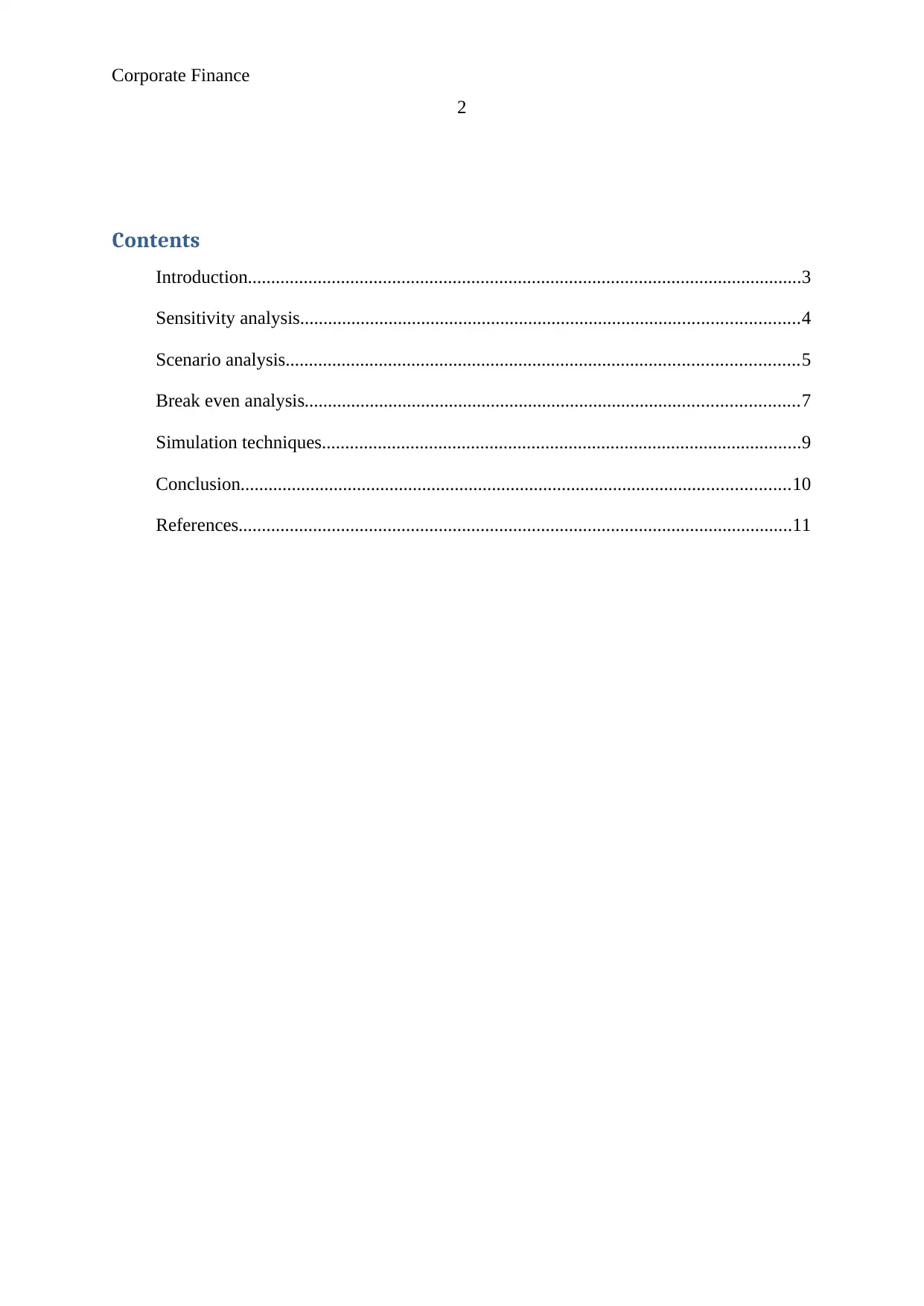
Corporate Finance
2
Contents
Introduction.......................................................................................................................3
Sensitivity analysis...........................................................................................................4
Scenario analysis..............................................................................................................5
Break even analysis..........................................................................................................7
Simulation techniques.......................................................................................................9
Conclusion......................................................................................................................10
References.......................................................................................................................11
2
Contents
Introduction.......................................................................................................................3
Sensitivity analysis...........................................................................................................4
Scenario analysis..............................................................................................................5
Break even analysis..........................................................................................................7
Simulation techniques.......................................................................................................9
Conclusion......................................................................................................................10
References.......................................................................................................................11

Corporate Finance
3
Introduction:
Corporate decision making is required by an organization at every step. Corporate
decision making is a crucial process in which various options are evaluated by the managers
of the company and then they make a crucial decision about the available options by
choosing the best option from them. In capital budgeting techniques, corporate decision also
plays a significant role. In this study, the corporate decision process in capital budgeting
techniques has been analyzed. Capital budgeting is an investigation process in which various
investment proposal are analyzed on the basis of various aspects. And then a best proposal is
chose by the company to make more profits and satisfying the needs of customers as well as
the stakeholders (Bodie, 2013). Various aspect of capital budgeting technique is evaluated on
the basis of the total profit through that project, the total time period in which the company
would be able to get back the entire amount, the internal rate of the project, accounting rate of
return of the project etc.
Normally, the process of capital budgeting technique is implemented by the
companies to analyze the long term projects which have a life of more than 2-3 years.
Corporate decision making is a tool which analyzes the project on the basis of various
techniques such as break even analysis, scenario analysis, sensitivity analysis, simulation
technique etc (Bierman and Smidt, 2012). In this report, the decision process has been
implemented according to the Net present value of the project, payback period of the project,
internal rate of return , average rate of return etc.
In addition, every firm investigates the entire available project according to various
tools and techniques as the main motto of the company is to make high profits. For this,
company considers the return factor from that project as well as entire associated risk with
the project. So, it becomes essential for a firm to analyze every project according to the above
3
Introduction:
Corporate decision making is required by an organization at every step. Corporate
decision making is a crucial process in which various options are evaluated by the managers
of the company and then they make a crucial decision about the available options by
choosing the best option from them. In capital budgeting techniques, corporate decision also
plays a significant role. In this study, the corporate decision process in capital budgeting
techniques has been analyzed. Capital budgeting is an investigation process in which various
investment proposal are analyzed on the basis of various aspects. And then a best proposal is
chose by the company to make more profits and satisfying the needs of customers as well as
the stakeholders (Bodie, 2013). Various aspect of capital budgeting technique is evaluated on
the basis of the total profit through that project, the total time period in which the company
would be able to get back the entire amount, the internal rate of the project, accounting rate of
return of the project etc.
Normally, the process of capital budgeting technique is implemented by the
companies to analyze the long term projects which have a life of more than 2-3 years.
Corporate decision making is a tool which analyzes the project on the basis of various
techniques such as break even analysis, scenario analysis, sensitivity analysis, simulation
technique etc (Bierman and Smidt, 2012). In this report, the decision process has been
implemented according to the Net present value of the project, payback period of the project,
internal rate of return , average rate of return etc.
In addition, every firm investigates the entire available project according to various
tools and techniques as the main motto of the company is to make high profits. For this,
company considers the return factor from that project as well as entire associated risk with
the project. So, it becomes essential for a firm to analyze every project according to the above
⊘ This is a preview!⊘
Do you want full access?
Subscribe today to unlock all pages.

Trusted by 1+ million students worldwide
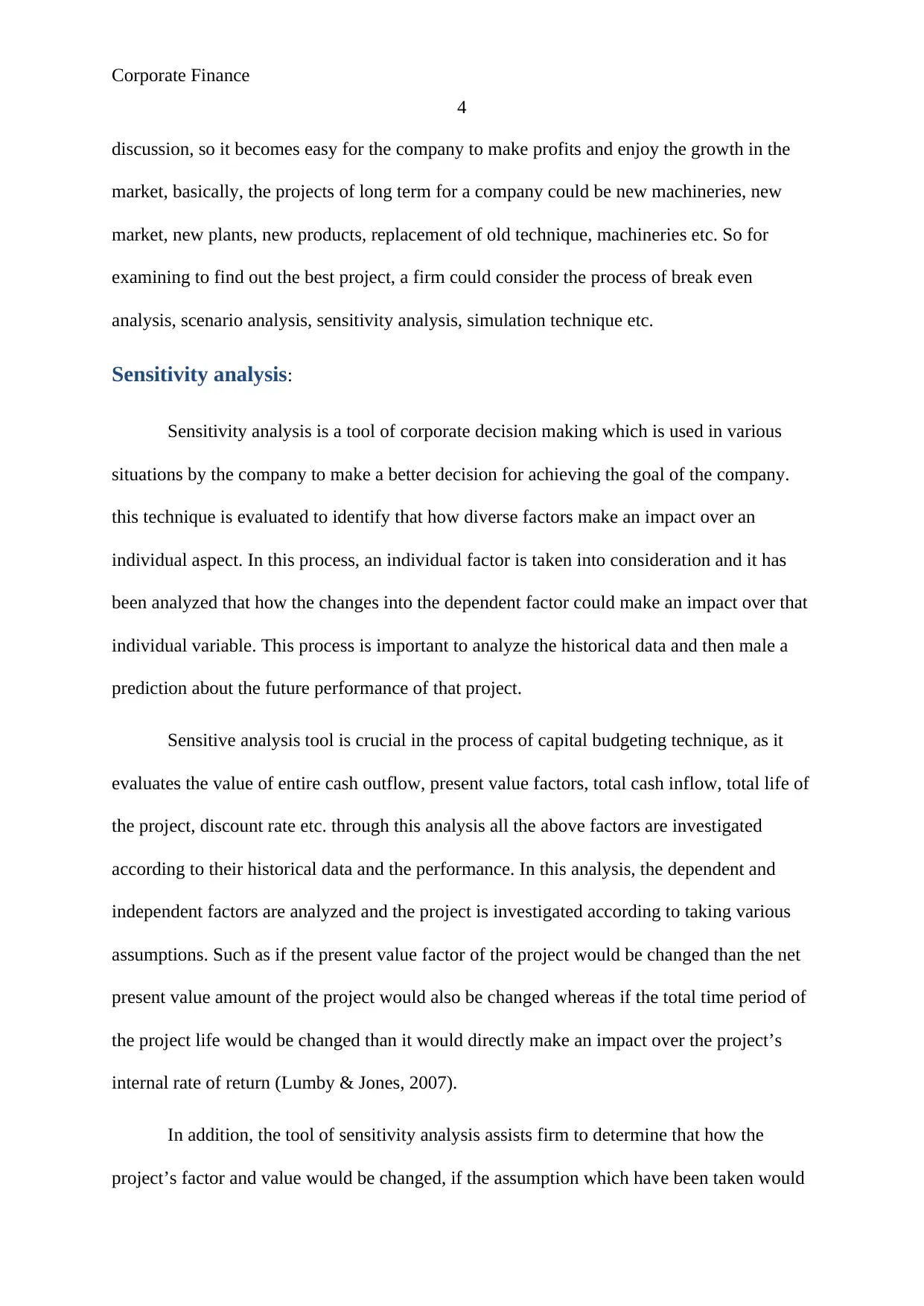
Corporate Finance
4
discussion, so it becomes easy for the company to make profits and enjoy the growth in the
market, basically, the projects of long term for a company could be new machineries, new
market, new plants, new products, replacement of old technique, machineries etc. So for
examining to find out the best project, a firm could consider the process of break even
analysis, scenario analysis, sensitivity analysis, simulation technique etc.
Sensitivity analysis:
Sensitivity analysis is a tool of corporate decision making which is used in various
situations by the company to make a better decision for achieving the goal of the company.
this technique is evaluated to identify that how diverse factors make an impact over an
individual aspect. In this process, an individual factor is taken into consideration and it has
been analyzed that how the changes into the dependent factor could make an impact over that
individual variable. This process is important to analyze the historical data and then male a
prediction about the future performance of that project.
Sensitive analysis tool is crucial in the process of capital budgeting technique, as it
evaluates the value of entire cash outflow, present value factors, total cash inflow, total life of
the project, discount rate etc. through this analysis all the above factors are investigated
according to their historical data and the performance. In this analysis, the dependent and
independent factors are analyzed and the project is investigated according to taking various
assumptions. Such as if the present value factor of the project would be changed than the net
present value amount of the project would also be changed whereas if the total time period of
the project life would be changed than it would directly make an impact over the project’s
internal rate of return (Lumby & Jones, 2007).
In addition, the tool of sensitivity analysis assists firm to determine that how the
project’s factor and value would be changed, if the assumption which have been taken would
4
discussion, so it becomes easy for the company to make profits and enjoy the growth in the
market, basically, the projects of long term for a company could be new machineries, new
market, new plants, new products, replacement of old technique, machineries etc. So for
examining to find out the best project, a firm could consider the process of break even
analysis, scenario analysis, sensitivity analysis, simulation technique etc.
Sensitivity analysis:
Sensitivity analysis is a tool of corporate decision making which is used in various
situations by the company to make a better decision for achieving the goal of the company.
this technique is evaluated to identify that how diverse factors make an impact over an
individual aspect. In this process, an individual factor is taken into consideration and it has
been analyzed that how the changes into the dependent factor could make an impact over that
individual variable. This process is important to analyze the historical data and then male a
prediction about the future performance of that project.
Sensitive analysis tool is crucial in the process of capital budgeting technique, as it
evaluates the value of entire cash outflow, present value factors, total cash inflow, total life of
the project, discount rate etc. through this analysis all the above factors are investigated
according to their historical data and the performance. In this analysis, the dependent and
independent factors are analyzed and the project is investigated according to taking various
assumptions. Such as if the present value factor of the project would be changed than the net
present value amount of the project would also be changed whereas if the total time period of
the project life would be changed than it would directly make an impact over the project’s
internal rate of return (Lumby & Jones, 2007).
In addition, the tool of sensitivity analysis assists firm to determine that how the
project’s factor and value would be changed, if the assumption which have been taken would
Paraphrase This Document
Need a fresh take? Get an instant paraphrase of this document with our AI Paraphraser
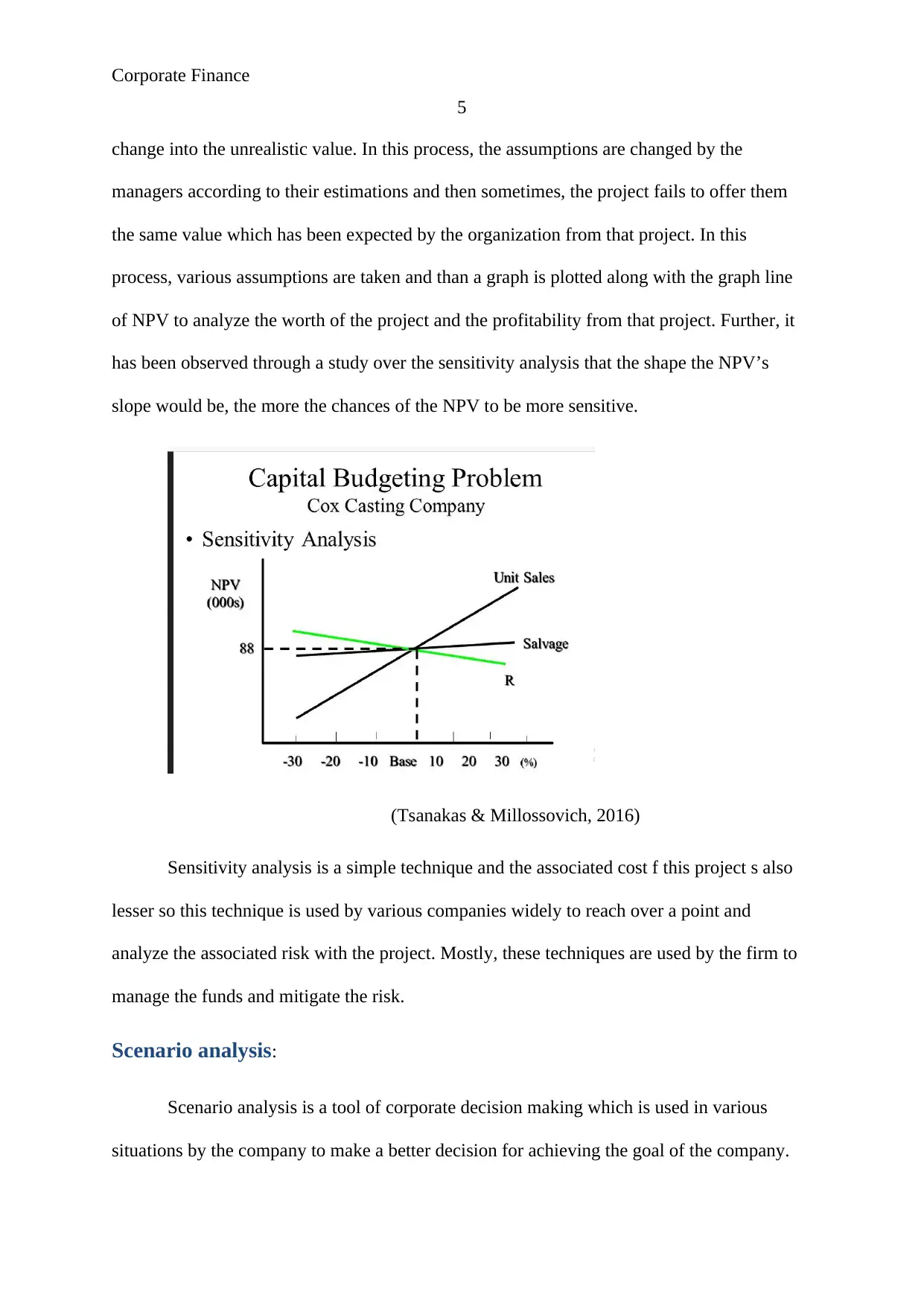
Corporate Finance
5
change into the unrealistic value. In this process, the assumptions are changed by the
managers according to their estimations and then sometimes, the project fails to offer them
the same value which has been expected by the organization from that project. In this
process, various assumptions are taken and than a graph is plotted along with the graph line
of NPV to analyze the worth of the project and the profitability from that project. Further, it
has been observed through a study over the sensitivity analysis that the shape the NPV’s
slope would be, the more the chances of the NPV to be more sensitive.
(Tsanakas & Millossovich, 2016)
Sensitivity analysis is a simple technique and the associated cost f this project s also
lesser so this technique is used by various companies widely to reach over a point and
analyze the associated risk with the project. Mostly, these techniques are used by the firm to
manage the funds and mitigate the risk.
Scenario analysis:
Scenario analysis is a tool of corporate decision making which is used in various
situations by the company to make a better decision for achieving the goal of the company.
5
change into the unrealistic value. In this process, the assumptions are changed by the
managers according to their estimations and then sometimes, the project fails to offer them
the same value which has been expected by the organization from that project. In this
process, various assumptions are taken and than a graph is plotted along with the graph line
of NPV to analyze the worth of the project and the profitability from that project. Further, it
has been observed through a study over the sensitivity analysis that the shape the NPV’s
slope would be, the more the chances of the NPV to be more sensitive.
(Tsanakas & Millossovich, 2016)
Sensitivity analysis is a simple technique and the associated cost f this project s also
lesser so this technique is used by various companies widely to reach over a point and
analyze the associated risk with the project. Mostly, these techniques are used by the firm to
manage the funds and mitigate the risk.
Scenario analysis:
Scenario analysis is a tool of corporate decision making which is used in various
situations by the company to make a better decision for achieving the goal of the company.

Corporate Finance
6
This technique is evaluated to identify that how diverse factors make an impact over various
individual aspects. Earlier, sensitive analysis was used by the companies to determine the
project. But in this process, only changes into a single factor is examined which is not
realistic in actual. In this process, various individual factors are taken into consideration and
it has been analyzed that how the changes into the dependent factor could make an impact
over that individual variable. This process do not look over the historical data instead of that,
this process makes the possible outcome in future (Seitzinger et al, 2010). This process does
not show a single picture of the project whereas it depicts various situations which could take
place in future. Such as if these values would take place than the case would be average, if
there would be few changes into the values positively and negatively than these values could
be converted into worst and best case.
Scenario analysis tool is crucial in the process of capital budgeting technique, as it
offers the detailed result of every situation and helps the organization to make a better
decision after considering entire related aspects. Through this analysis all the related factors
are analyzed such as exchange rate, yield, marketing cost, transportation cost, cash inflow,
cash outflow, selling price, NPV etc. In this analysis, the dependent and independent factors
are analyzed and the project is investigated according to taking various assumptions (Moles,
Parrino & Kidwekk, 2011). Such as if the present value factor of the project would be
changed negatively than the project would be converted into best scenario and conversely, if
the present value factor would be enhanced than the project would be converted into worst
scenario.
Normally, for analyzing a project according to the scenario analysis, probability
distribution techniques are considered. As through these mathematical calculations, it
becomes easy for the company to make a better decision about the projects. This analysis
6
This technique is evaluated to identify that how diverse factors make an impact over various
individual aspects. Earlier, sensitive analysis was used by the companies to determine the
project. But in this process, only changes into a single factor is examined which is not
realistic in actual. In this process, various individual factors are taken into consideration and
it has been analyzed that how the changes into the dependent factor could make an impact
over that individual variable. This process do not look over the historical data instead of that,
this process makes the possible outcome in future (Seitzinger et al, 2010). This process does
not show a single picture of the project whereas it depicts various situations which could take
place in future. Such as if these values would take place than the case would be average, if
there would be few changes into the values positively and negatively than these values could
be converted into worst and best case.
Scenario analysis tool is crucial in the process of capital budgeting technique, as it
offers the detailed result of every situation and helps the organization to make a better
decision after considering entire related aspects. Through this analysis all the related factors
are analyzed such as exchange rate, yield, marketing cost, transportation cost, cash inflow,
cash outflow, selling price, NPV etc. In this analysis, the dependent and independent factors
are analyzed and the project is investigated according to taking various assumptions (Moles,
Parrino & Kidwekk, 2011). Such as if the present value factor of the project would be
changed negatively than the project would be converted into best scenario and conversely, if
the present value factor would be enhanced than the project would be converted into worst
scenario.
Normally, for analyzing a project according to the scenario analysis, probability
distribution techniques are considered. As through these mathematical calculations, it
becomes easy for the company to make a better decision about the projects. This analysis
⊘ This is a preview!⊘
Do you want full access?
Subscribe today to unlock all pages.

Trusted by 1+ million students worldwide

Corporate Finance
7
depict the manager that of these values would take place in future then the project would look
like that much terrible, good or best (Grant, 2016). The project prediction is done by the
managers after investigating over various factors such as compitetitor’s strategies, their point
of view, economical condition, project prediction etc. the following scenarios are made by the
managers of the company to analyze the project:
Factors Normal case Best case Worst case
Yield - + 10 % 20%
Exchange rate - + 10 % 10%
Transportation
cost
- -5% +20%
Marketing cost - -5% +20%
Sales cost - + 10 % 20%
Sales price 1.03 1.05 1.00
Cash inflow 17 % 29 % 1 %
NPV 1 2.2 -2.7
(Barlow, 2006)
7
depict the manager that of these values would take place in future then the project would look
like that much terrible, good or best (Grant, 2016). The project prediction is done by the
managers after investigating over various factors such as compitetitor’s strategies, their point
of view, economical condition, project prediction etc. the following scenarios are made by the
managers of the company to analyze the project:
Factors Normal case Best case Worst case
Yield - + 10 % 20%
Exchange rate - + 10 % 10%
Transportation
cost
- -5% +20%
Marketing cost - -5% +20%
Sales cost - + 10 % 20%
Sales price 1.03 1.05 1.00
Cash inflow 17 % 29 % 1 %
NPV 1 2.2 -2.7
(Barlow, 2006)
Paraphrase This Document
Need a fresh take? Get an instant paraphrase of this document with our AI Paraphraser
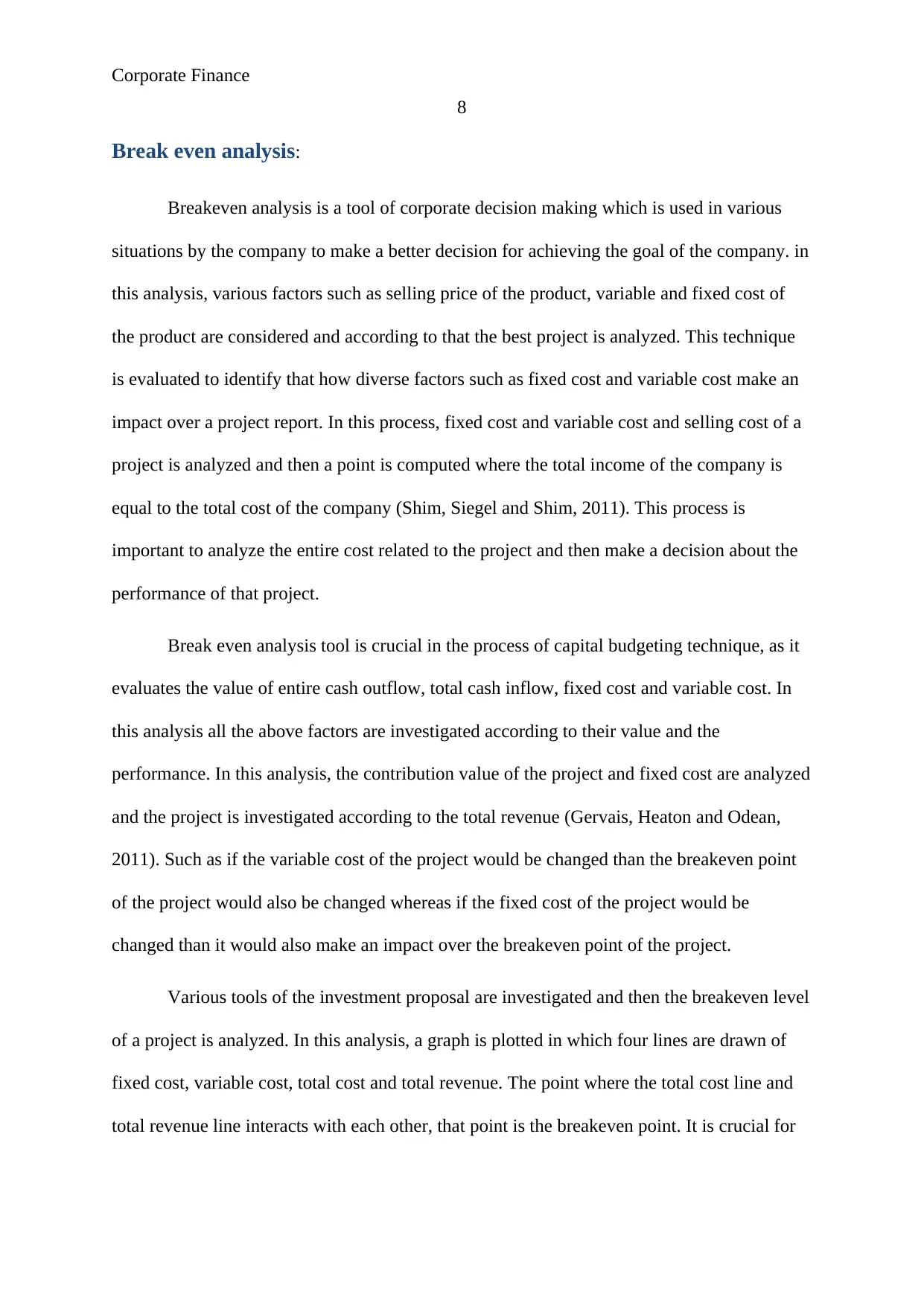
Corporate Finance
8
Break even analysis:
Breakeven analysis is a tool of corporate decision making which is used in various
situations by the company to make a better decision for achieving the goal of the company. in
this analysis, various factors such as selling price of the product, variable and fixed cost of
the product are considered and according to that the best project is analyzed. This technique
is evaluated to identify that how diverse factors such as fixed cost and variable cost make an
impact over a project report. In this process, fixed cost and variable cost and selling cost of a
project is analyzed and then a point is computed where the total income of the company is
equal to the total cost of the company (Shim, Siegel and Shim, 2011). This process is
important to analyze the entire cost related to the project and then make a decision about the
performance of that project.
Break even analysis tool is crucial in the process of capital budgeting technique, as it
evaluates the value of entire cash outflow, total cash inflow, fixed cost and variable cost. In
this analysis all the above factors are investigated according to their value and the
performance. In this analysis, the contribution value of the project and fixed cost are analyzed
and the project is investigated according to the total revenue (Gervais, Heaton and Odean,
2011). Such as if the variable cost of the project would be changed than the breakeven point
of the project would also be changed whereas if the fixed cost of the project would be
changed than it would also make an impact over the breakeven point of the project.
Various tools of the investment proposal are investigated and then the breakeven level
of a project is analyzed. In this analysis, a graph is plotted in which four lines are drawn of
fixed cost, variable cost, total cost and total revenue. The point where the total cost line and
total revenue line interacts with each other, that point is the breakeven point. It is crucial for
8
Break even analysis:
Breakeven analysis is a tool of corporate decision making which is used in various
situations by the company to make a better decision for achieving the goal of the company. in
this analysis, various factors such as selling price of the product, variable and fixed cost of
the product are considered and according to that the best project is analyzed. This technique
is evaluated to identify that how diverse factors such as fixed cost and variable cost make an
impact over a project report. In this process, fixed cost and variable cost and selling cost of a
project is analyzed and then a point is computed where the total income of the company is
equal to the total cost of the company (Shim, Siegel and Shim, 2011). This process is
important to analyze the entire cost related to the project and then make a decision about the
performance of that project.
Break even analysis tool is crucial in the process of capital budgeting technique, as it
evaluates the value of entire cash outflow, total cash inflow, fixed cost and variable cost. In
this analysis all the above factors are investigated according to their value and the
performance. In this analysis, the contribution value of the project and fixed cost are analyzed
and the project is investigated according to the total revenue (Gervais, Heaton and Odean,
2011). Such as if the variable cost of the project would be changed than the breakeven point
of the project would also be changed whereas if the fixed cost of the project would be
changed than it would also make an impact over the breakeven point of the project.
Various tools of the investment proposal are investigated and then the breakeven level
of a project is analyzed. In this analysis, a graph is plotted in which four lines are drawn of
fixed cost, variable cost, total cost and total revenue. The point where the total cost line and
total revenue line interacts with each other, that point is the breakeven point. It is crucial for
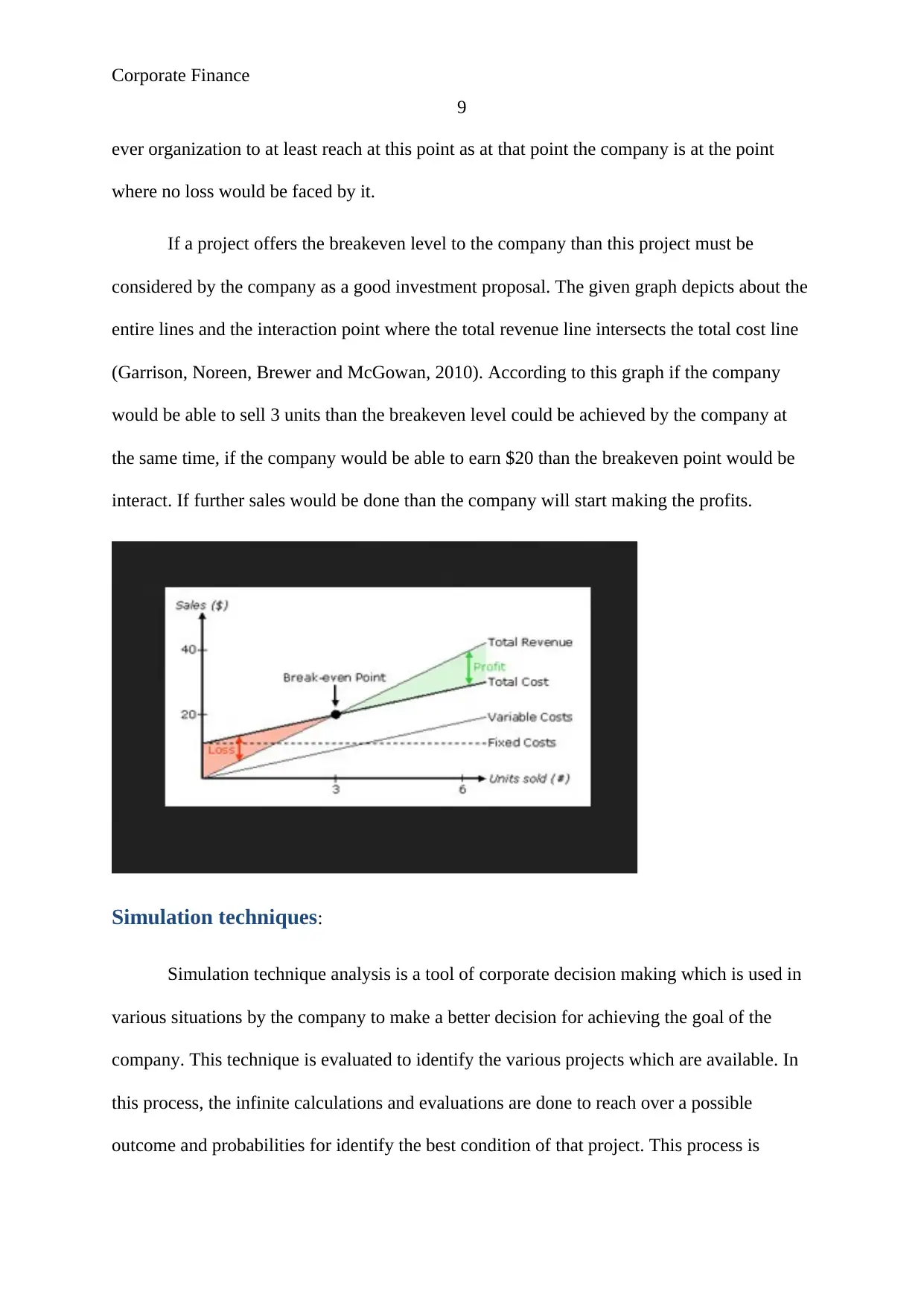
Corporate Finance
9
ever organization to at least reach at this point as at that point the company is at the point
where no loss would be faced by it.
If a project offers the breakeven level to the company than this project must be
considered by the company as a good investment proposal. The given graph depicts about the
entire lines and the interaction point where the total revenue line intersects the total cost line
(Garrison, Noreen, Brewer and McGowan, 2010). According to this graph if the company
would be able to sell 3 units than the breakeven level could be achieved by the company at
the same time, if the company would be able to earn $20 than the breakeven point would be
interact. If further sales would be done than the company will start making the profits.
Simulation techniques:
Simulation technique analysis is a tool of corporate decision making which is used in
various situations by the company to make a better decision for achieving the goal of the
company. This technique is evaluated to identify the various projects which are available. In
this process, the infinite calculations and evaluations are done to reach over a possible
outcome and probabilities for identify the best condition of that project. This process is
9
ever organization to at least reach at this point as at that point the company is at the point
where no loss would be faced by it.
If a project offers the breakeven level to the company than this project must be
considered by the company as a good investment proposal. The given graph depicts about the
entire lines and the interaction point where the total revenue line intersects the total cost line
(Garrison, Noreen, Brewer and McGowan, 2010). According to this graph if the company
would be able to sell 3 units than the breakeven level could be achieved by the company at
the same time, if the company would be able to earn $20 than the breakeven point would be
interact. If further sales would be done than the company will start making the profits.
Simulation techniques:
Simulation technique analysis is a tool of corporate decision making which is used in
various situations by the company to make a better decision for achieving the goal of the
company. This technique is evaluated to identify the various projects which are available. In
this process, the infinite calculations and evaluations are done to reach over a possible
outcome and probabilities for identify the best condition of that project. This process is
⊘ This is a preview!⊘
Do you want full access?
Subscribe today to unlock all pages.

Trusted by 1+ million students worldwide
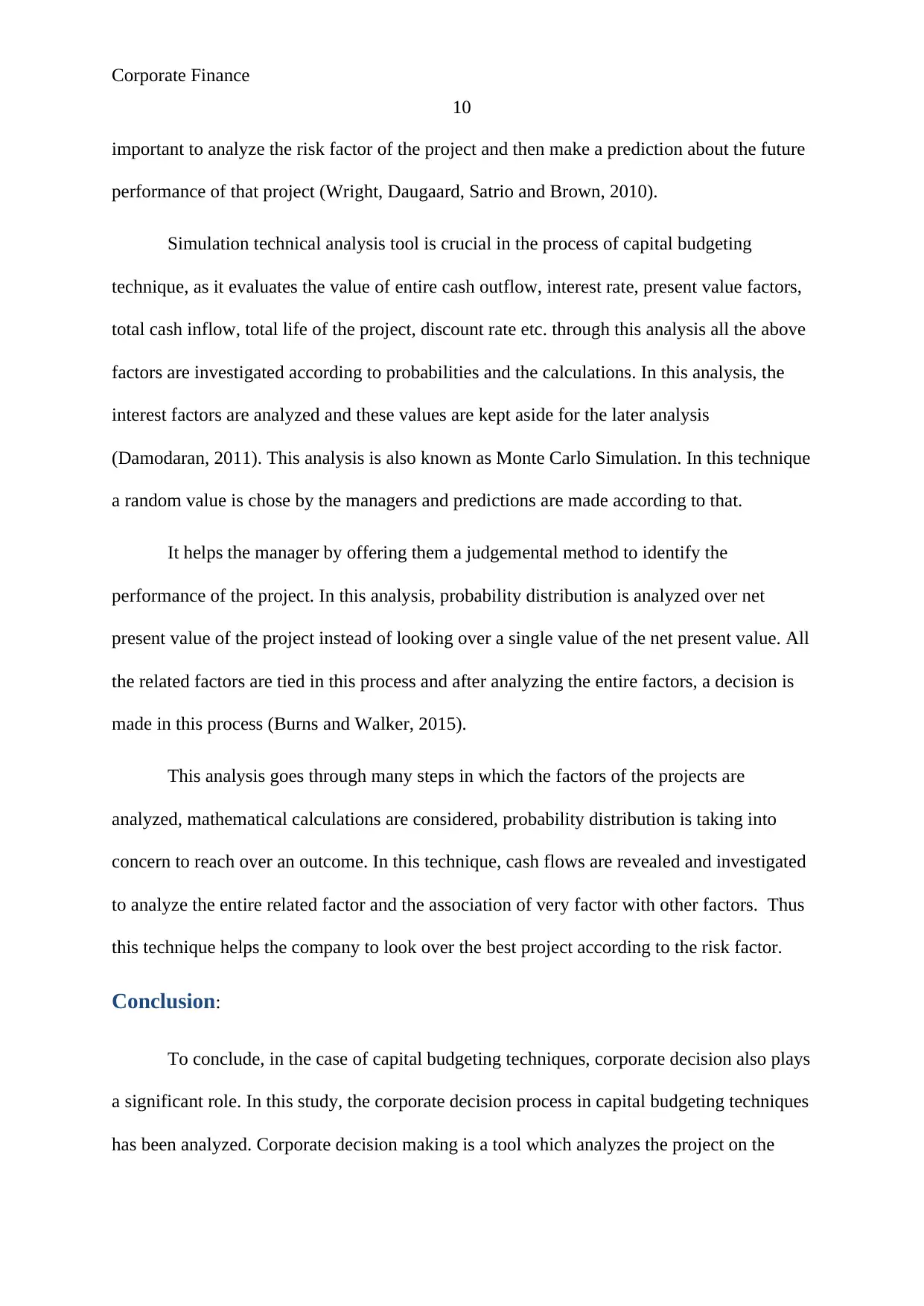
Corporate Finance
10
important to analyze the risk factor of the project and then make a prediction about the future
performance of that project (Wright, Daugaard, Satrio and Brown, 2010).
Simulation technical analysis tool is crucial in the process of capital budgeting
technique, as it evaluates the value of entire cash outflow, interest rate, present value factors,
total cash inflow, total life of the project, discount rate etc. through this analysis all the above
factors are investigated according to probabilities and the calculations. In this analysis, the
interest factors are analyzed and these values are kept aside for the later analysis
(Damodaran, 2011). This analysis is also known as Monte Carlo Simulation. In this technique
a random value is chose by the managers and predictions are made according to that.
It helps the manager by offering them a judgemental method to identify the
performance of the project. In this analysis, probability distribution is analyzed over net
present value of the project instead of looking over a single value of the net present value. All
the related factors are tied in this process and after analyzing the entire factors, a decision is
made in this process (Burns and Walker, 2015).
This analysis goes through many steps in which the factors of the projects are
analyzed, mathematical calculations are considered, probability distribution is taking into
concern to reach over an outcome. In this technique, cash flows are revealed and investigated
to analyze the entire related factor and the association of very factor with other factors. Thus
this technique helps the company to look over the best project according to the risk factor.
Conclusion:
To conclude, in the case of capital budgeting techniques, corporate decision also plays
a significant role. In this study, the corporate decision process in capital budgeting techniques
has been analyzed. Corporate decision making is a tool which analyzes the project on the
10
important to analyze the risk factor of the project and then make a prediction about the future
performance of that project (Wright, Daugaard, Satrio and Brown, 2010).
Simulation technical analysis tool is crucial in the process of capital budgeting
technique, as it evaluates the value of entire cash outflow, interest rate, present value factors,
total cash inflow, total life of the project, discount rate etc. through this analysis all the above
factors are investigated according to probabilities and the calculations. In this analysis, the
interest factors are analyzed and these values are kept aside for the later analysis
(Damodaran, 2011). This analysis is also known as Monte Carlo Simulation. In this technique
a random value is chose by the managers and predictions are made according to that.
It helps the manager by offering them a judgemental method to identify the
performance of the project. In this analysis, probability distribution is analyzed over net
present value of the project instead of looking over a single value of the net present value. All
the related factors are tied in this process and after analyzing the entire factors, a decision is
made in this process (Burns and Walker, 2015).
This analysis goes through many steps in which the factors of the projects are
analyzed, mathematical calculations are considered, probability distribution is taking into
concern to reach over an outcome. In this technique, cash flows are revealed and investigated
to analyze the entire related factor and the association of very factor with other factors. Thus
this technique helps the company to look over the best project according to the risk factor.
Conclusion:
To conclude, in the case of capital budgeting techniques, corporate decision also plays
a significant role. In this study, the corporate decision process in capital budgeting techniques
has been analyzed. Corporate decision making is a tool which analyzes the project on the
Paraphrase This Document
Need a fresh take? Get an instant paraphrase of this document with our AI Paraphraser
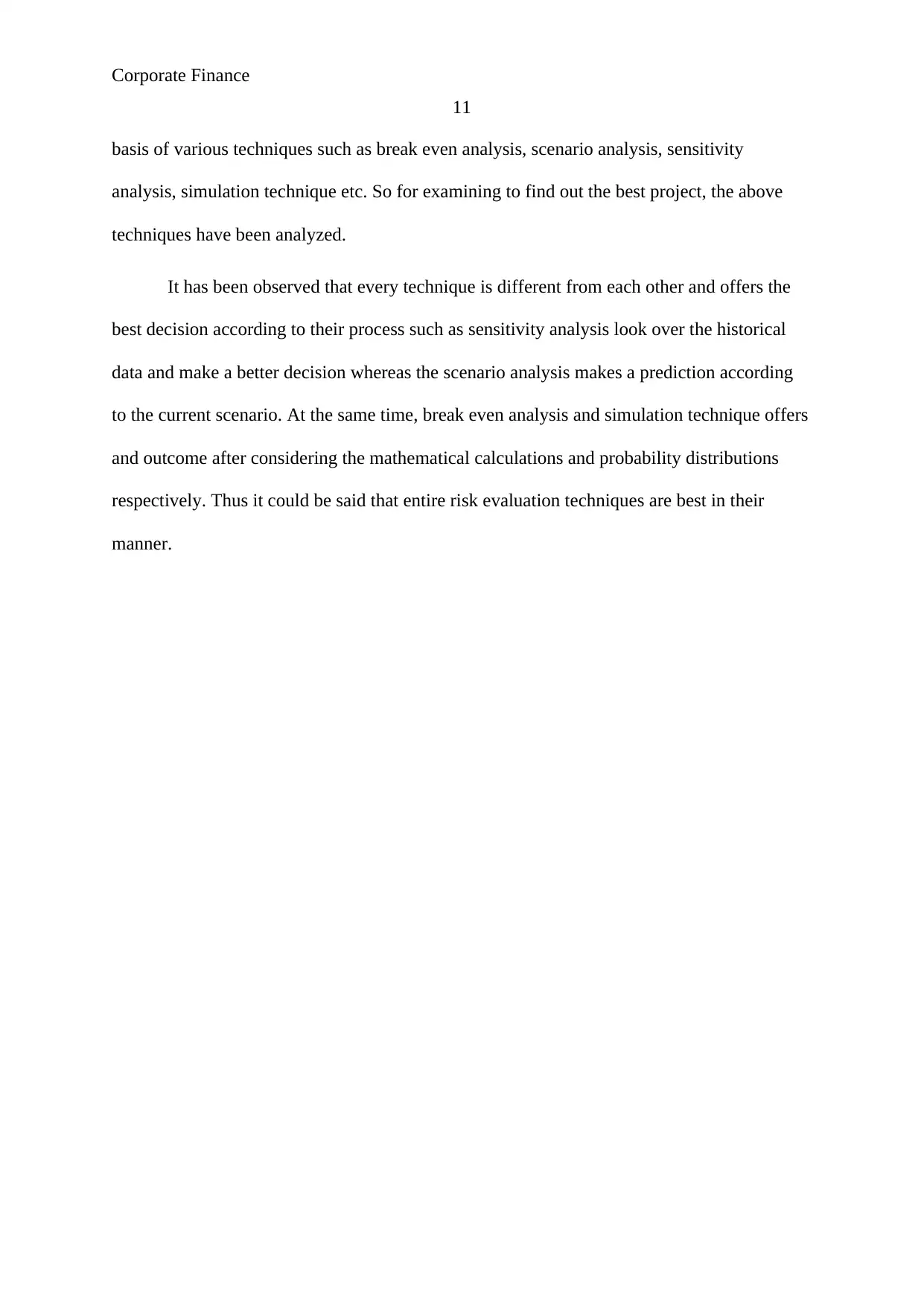
Corporate Finance
11
basis of various techniques such as break even analysis, scenario analysis, sensitivity
analysis, simulation technique etc. So for examining to find out the best project, the above
techniques have been analyzed.
It has been observed that every technique is different from each other and offers the
best decision according to their process such as sensitivity analysis look over the historical
data and make a better decision whereas the scenario analysis makes a prediction according
to the current scenario. At the same time, break even analysis and simulation technique offers
and outcome after considering the mathematical calculations and probability distributions
respectively. Thus it could be said that entire risk evaluation techniques are best in their
manner.
11
basis of various techniques such as break even analysis, scenario analysis, sensitivity
analysis, simulation technique etc. So for examining to find out the best project, the above
techniques have been analyzed.
It has been observed that every technique is different from each other and offers the
best decision according to their process such as sensitivity analysis look over the historical
data and make a better decision whereas the scenario analysis makes a prediction according
to the current scenario. At the same time, break even analysis and simulation technique offers
and outcome after considering the mathematical calculations and probability distributions
respectively. Thus it could be said that entire risk evaluation techniques are best in their
manner.
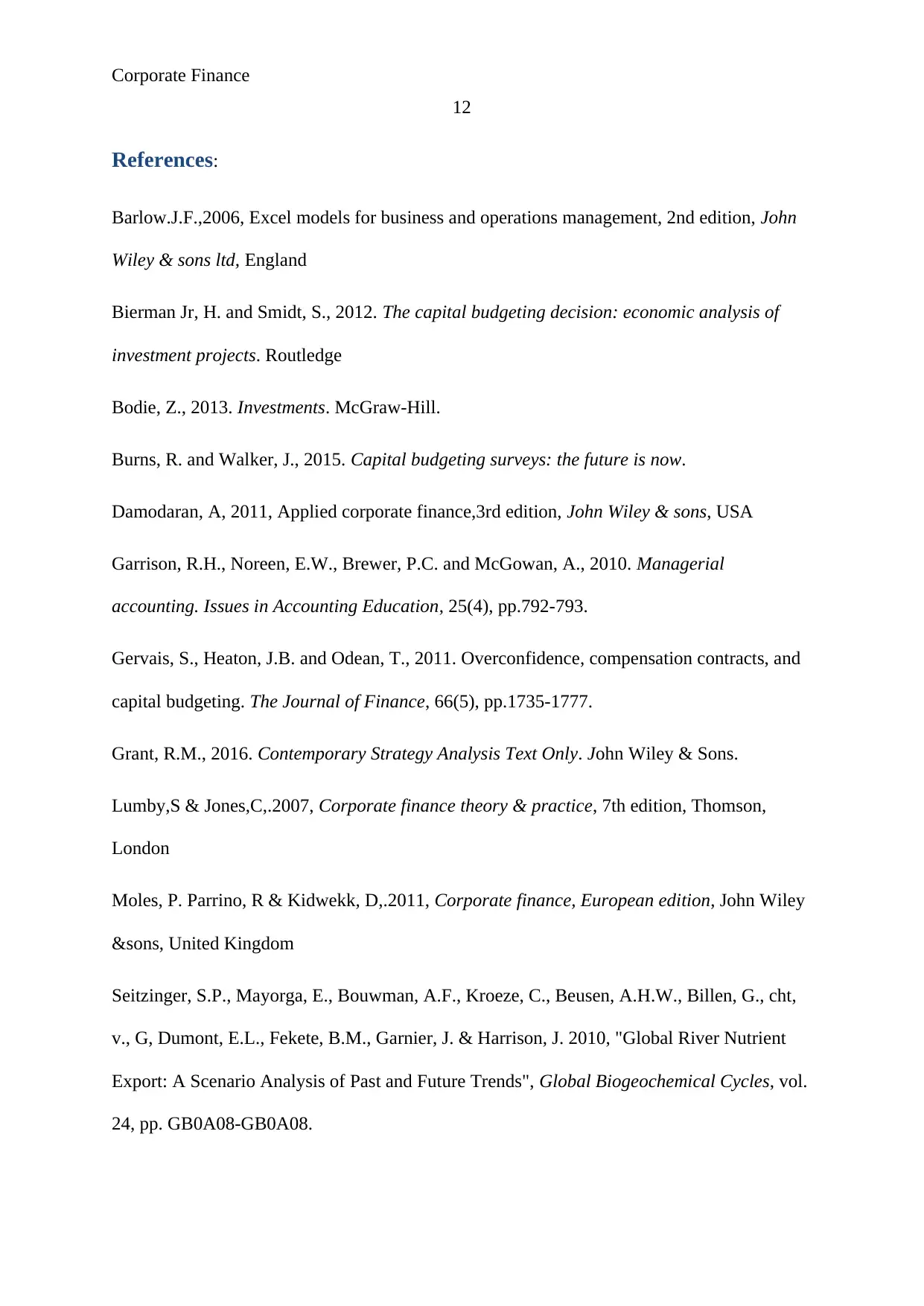
Corporate Finance
12
References:
Barlow.J.F.,2006, Excel models for business and operations management, 2nd edition, John
Wiley & sons ltd, England
Bierman Jr, H. and Smidt, S., 2012. The capital budgeting decision: economic analysis of
investment projects. Routledge
Bodie, Z., 2013. Investments. McGraw-Hill.
Burns, R. and Walker, J., 2015. Capital budgeting surveys: the future is now.
Damodaran, A, 2011, Applied corporate finance,3rd edition, John Wiley & sons, USA
Garrison, R.H., Noreen, E.W., Brewer, P.C. and McGowan, A., 2010. Managerial
accounting. Issues in Accounting Education, 25(4), pp.792-793.
Gervais, S., Heaton, J.B. and Odean, T., 2011. Overconfidence, compensation contracts, and
capital budgeting. The Journal of Finance, 66(5), pp.1735-1777.
Grant, R.M., 2016. Contemporary Strategy Analysis Text Only. John Wiley & Sons.
Lumby,S & Jones,C,.2007, Corporate finance theory & practice, 7th edition, Thomson,
London
Moles, P. Parrino, R & Kidwekk, D,.2011, Corporate finance, European edition, John Wiley
&sons, United Kingdom
Seitzinger, S.P., Mayorga, E., Bouwman, A.F., Kroeze, C., Beusen, A.H.W., Billen, G., cht,
v., G, Dumont, E.L., Fekete, B.M., Garnier, J. & Harrison, J. 2010, "Global River Nutrient
Export: A Scenario Analysis of Past and Future Trends", Global Biogeochemical Cycles, vol.
24, pp. GB0A08-GB0A08.
12
References:
Barlow.J.F.,2006, Excel models for business and operations management, 2nd edition, John
Wiley & sons ltd, England
Bierman Jr, H. and Smidt, S., 2012. The capital budgeting decision: economic analysis of
investment projects. Routledge
Bodie, Z., 2013. Investments. McGraw-Hill.
Burns, R. and Walker, J., 2015. Capital budgeting surveys: the future is now.
Damodaran, A, 2011, Applied corporate finance,3rd edition, John Wiley & sons, USA
Garrison, R.H., Noreen, E.W., Brewer, P.C. and McGowan, A., 2010. Managerial
accounting. Issues in Accounting Education, 25(4), pp.792-793.
Gervais, S., Heaton, J.B. and Odean, T., 2011. Overconfidence, compensation contracts, and
capital budgeting. The Journal of Finance, 66(5), pp.1735-1777.
Grant, R.M., 2016. Contemporary Strategy Analysis Text Only. John Wiley & Sons.
Lumby,S & Jones,C,.2007, Corporate finance theory & practice, 7th edition, Thomson,
London
Moles, P. Parrino, R & Kidwekk, D,.2011, Corporate finance, European edition, John Wiley
&sons, United Kingdom
Seitzinger, S.P., Mayorga, E., Bouwman, A.F., Kroeze, C., Beusen, A.H.W., Billen, G., cht,
v., G, Dumont, E.L., Fekete, B.M., Garnier, J. & Harrison, J. 2010, "Global River Nutrient
Export: A Scenario Analysis of Past and Future Trends", Global Biogeochemical Cycles, vol.
24, pp. GB0A08-GB0A08.
⊘ This is a preview!⊘
Do you want full access?
Subscribe today to unlock all pages.

Trusted by 1+ million students worldwide
1 out of 13
Related Documents
Your All-in-One AI-Powered Toolkit for Academic Success.
+13062052269
info@desklib.com
Available 24*7 on WhatsApp / Email
![[object Object]](/_next/static/media/star-bottom.7253800d.svg)
Unlock your academic potential
Copyright © 2020–2025 A2Z Services. All Rights Reserved. Developed and managed by ZUCOL.





